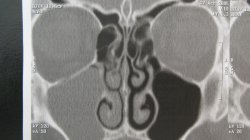Our Approach for Treatment of Chronic Sinusitis Munich
The most common early symptom of sinusitis is nasal congestion. This ailment starts gradually, but infection and inflammation can intensely develop to acute sinusitis. Additional early symptoms include chronic nasal discharge, frequent headaches, susceptibility for infection, middle ear infection and associated allergic reactions.
Sinusitis Diagnostics Munich
We apply endoscopy and sonography in our investigations of the nasal sinuses. It is our point of view that allergologic diagnostics are also of cardinal importance. Today, allergy is like a common ´´social disease´´ and needs to be considered as a likely contributor to the cause of chronic sinusitis. Usually, a computed tomography scan of the sinuses is necessary to form a clear picture of the specificity and the precise anatomical localization of the inflammation.
NEW: Balloon Sinuplasty of the Paranasal Sinuses Munich
Learn more about this new and extremely gentle method for treatment of chronic sinusitis.
Conservative and Minimally Invasive Treatment Munich
Our first-line treatment is to combine medication with physical therapy.
In the event of inadequate response to therapy, the next stage of treatment involves minimally invasive measures to restore nasal and sinus airflow. At this stage, we recommend reducing the size of the turbinate (this is cartilage or soft bony tissue in the nose) with coblation through the implementation of coblation conchotomy (coblation-assisted partial turbinoplasty (CAPT)). This is performed under local anesthesia. In the broadest sense, this procedure is associated with radio frequency therapy. It consists of the targeted generation of scar tissue under the intact mucous membranes of the nose.
This creates an internal corset that significantly reduces volume, thereby improving ventilation whilst preserving the mucous membranes. In our opinion, by preserving the mucosa, coblation conchotomy has a great advantage over laser conchotomy (laser-assisted conchotomy (LACON)). The swellings and infections which often occur after laser treatment are unheard of with our preferred technique.
In some cases, remedy for more pronounced symptoms may ultimately only be achieved through functional endoscopic sinus surgery (FESS).
Surgery and Post-Operative Recovery Munich
Functional Endoscopic Sinus Surgery (FESS) Munich
The principle of this procedure is to create one or more, bigger self-cleaning sinus cavities with a larger drainage system from numerous smaller sinus cavities whose drainage is hindered by chronic inflammation. Diseased bony structures and mucosal inflammation are precisely removed, leaving islands of healthy mucous membrane intact. This is followed by post-operative recovery.
For minor procedures, the surgery is performed under general anesthesia without the need for hospitalization. Another advantage of using coblation conchotomy is that even the dreaded nasal packing can be entirely omitted (which is otherwise commonly applied to arrest post-operative bleeding).
For more extensive surgery, the patient is hospitalized for approximately 4 days. With quick recovery this period can be shortened.


